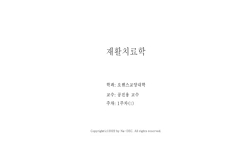The number of species and forest area has decreased as urbanization is progressed. The landscape degradation was examined by analyzing vegetation map, satellite image and characteristics of actual vegetation. The study was conducted in Mt. Baekja and ...
http://chineseinput.net/에서 pinyin(병음)방식으로 중국어를 변환할 수 있습니다.
변환된 중국어를 복사하여 사용하시면 됩니다.
- 中文 을 입력하시려면 zhongwen을 입력하시고 space를누르시면됩니다.
- 北京 을 입력하시려면 beijing을 입력하시고 space를 누르시면 됩니다.


Degradation of Lowland Forest Landscape and Management Strategy to Improve Ecological Quality in Mt. Baekja and Its Surroundings
한글로보기https://www.riss.kr/link?id=A105142388
- 저자
- 발행기관
- 학술지명
- 권호사항
-
발행연도
2006
-
작성언어
English
- 주제어
-
등재정보
SCOPUS,KCI등재
-
자료형태
학술저널
- 발행기관 URL
-
수록면
445-452(8쪽)
- 제공처
- 소장기관
-
0
상세조회 -
0
다운로드
부가정보
다국어 초록 (Multilingual Abstract)
The number of species and forest area has decreased as urbanization is progressed. The landscape degradation was examined by analyzing vegetation map, satellite image and characteristics of actual vegetation. The study was conducted in Mt. Baekja and its surroundings located on Gyeongsan city, southeastern Korea. As the result of landscape analysis, agricultural field was a characteristic attribute of the study area. Lowlands of this study area were occupied by agricultural field and various plantations. For 15 years from 1987 to 2002, forest area decreased from 2,072.9 ha to 1,853.2 ha, and shape index and fractal dimension of vegetation patches increased from 1.32 to 1.65 and from 1.05 to 1.09, respectively. Pinus densiflora Siebold & Zucco. community showed the highest species diversity, whereas Larix kaempferi (Lamb.) Carriere community showed the lowest species abundance. As forest management implications, monitoring of endangered plant species (Jeffersonia dubia (Maxim.) Benth. & Hook.f. ex Baker & S.Moore), and restoration of lowland forest from plantation to natural forest were discussed. Further, establishment of greenways utilizing existing streams, roadside, and public facilities were recommended.
동일학술지(권/호) 다른 논문
-
Comparison of Mating System in Populations of Gleditsia japonica var. koraiensis
- 한국생태학회
- 허만규
- 2006
- SCOPUS,KCI등재
-
Carbon Assimilation and Respiration of Daphnia magna with Varying Algal Food Quality
- 한국생태학회
- 박상규
- 2006
- SCOPUS,KCI등재
-
Growth Rate and Nutrient Content Changes of Humulus japonicus
- 한국생태학회
- 주은정
- 2006
- SCOPUS,KCI등재
-
- 한국생태학회
- 김흥태
- 2006
- SCOPUS,KCI등재




 ScienceON
ScienceON







